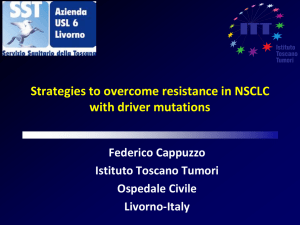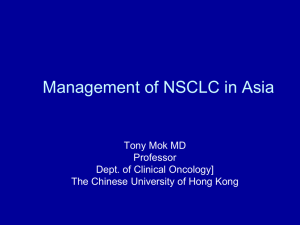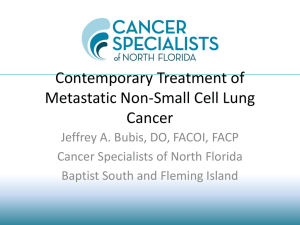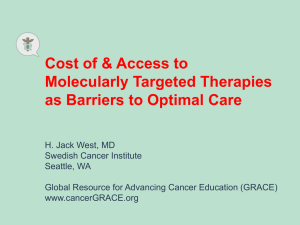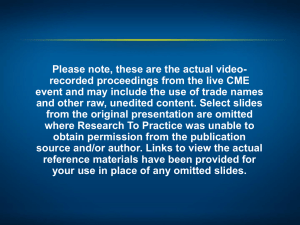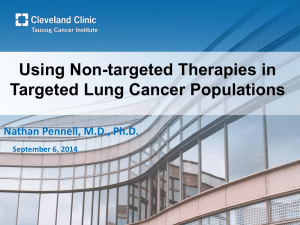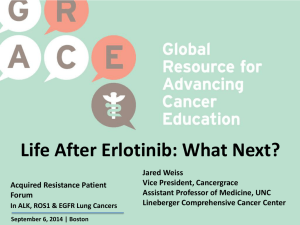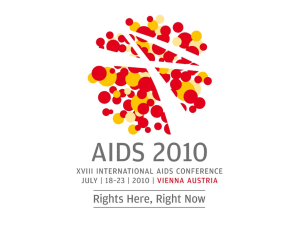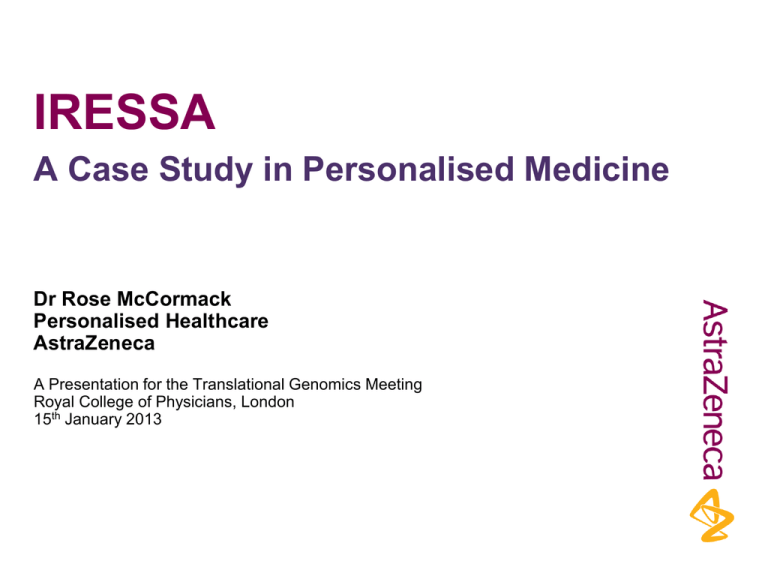
IRESSA
A Case Study in Personalised Medicine
Dr Rose McCormack
Personalised Healthcare
AstraZeneca
A Presentation for the Translational Genomics Meeting
Royal College of Physicians, London
15th January 2013
The drug
The
biomarkers
and clinical
trials
AN OVERVIEW
Implications
for
Diagnostics
Our
experience
and
learnings
The drug
THE DRUG
The
biomarkers
and clinical
trials
Implications
for
Diagnostics
Our
experience
and
learnings
Gefitinib (IRESSA™): A brief overview
• Gefitinib is a once-daily 250mg oral medication
that targets and blocks the activity of the EGFRTK
• Gefitinib was the first EGFR-TK inhibitor to be
approved for use in non-small cell lung cancer
• Gefitinib has demonstrated longer progressionfree survival, better tolerability and quality of life
compared with doublet chemotherapy
(carboplatin/paclitaxel) in first-line treatment for
EGFR mutation-positive advanced NSCLC.
• On the 1st July 2009 the European Commission
granted marketing authorisation for gefitinib for
the treatment of adults with locally advanced or
metastatic NSCLC with activating mutations of
EGFR-TK across all lines of therapy
• Gefitinib is currently approved for the treatment
of 1st line EGFR M+ advanced NSCLC patients
in 85 countries worldwide
The drug
The
biomarkers
and clinical
trials
Implications
for
Diagnostics
Our
experience
and
learnings
THE BIOMARKERS AND CLINICAL TRIALS
Lessons in Biomarker Analysis
Chromosome
DNA
mRNA
Gene
Copy
Number
(FISH)
DNA
Mutation
Analysis
(e.g.
ARMS)
Expression
Analysis
(e.g. Array,
RT-PCR etc)
Protein
Protein
Expression
Analysis
(e.g. IHC)
PI3K
Grb-2
SOS
PTEN
Ras
Raf
Akt
MEK
mTOR
STAT 3/5
MAPK
Pao & Miller 2005
Tumour cell
survival
Tumour cell
proliferation
The Trials: A Brief History
ISEL, INTEREST: Unselected
trials in pre-treated setting
ISEL
IRESSA
registration
Japan
2002 2003 2004
INTEREST
2005 2006 2007 2008 2009
EGFR protein expression
EGFR gene copy number
EGFR mutations: First observed in 2004
Lynch et al 2004 (New Eng J Med 350:2129- 2139)
Activating Mutations in the Epidermal
Growth Factor Receptor Underlying
Responsiveness of Non-Small-Cell Lung
Cancer to Gefitinib
Paez et al 2004 (Science 304:1497-1500)
EGFR Mutations in Lung Cancer:
Correlation with Clinical Response to
Gefitinib Therapy
Mitsudomi T et al: J Clin Oncol 23 (11), 2005: 2513-2520
Mutations of the epidermal growth factor
receptor gene predict prolonged survival
after gefitinib treatment in patients with nonsmall-cell lung cancer with postoperative
recurrence.
Reprinted with permission. © 2005 American Society of
Clinical Oncology. All rights reserved.
The Trials: A Brief History
ISEL, INTEREST: Unselected
trials in pre-treated setting
IPASS: Clinically selected
trial in first line setting
ISEL
IRESSA
registration
Japan
INTEREST
IPASS
2002 2003 2004
2005 2006 2007 2008 2009
EGFR protein expression
EGFR gene copy number
EGFR mutations
INTEREST: Phase III study of gefitinib vs
docetaxel in pre-treated NSCLC
Endpoints
Primary
Patients
• Progressive
or
recurrent disease
following CT
Gefitinib
250 mg/day
• Considered
candidates for
further CT with
docetaxel
•1
or 2 CT regimens
(≥1 platinum)
• PS
0-2
• 1466 patients
Kim 2008
• Overall survival
•(co-primary analyses of
non-inferiority in all patients and
superiority in patients with high EGFR
gene copy number)
Secondary
1:1 randomization
Docetaxel
75 mg/m2 every
3 weeks
• Progression-free survival
• Objective response rate
• Quality of life
• Disease related symptoms
• Safety and tolerability
Exploratory
• Biomarkers
•EGFR mutation
•EGFR protein expression
•EGFR gene copy number
•K-Ras mutation
INTEREST Results
OS: NI margin 1.154, PP population
PFS: EFR population
HR (96% CI) =1.020 (0.905, 1.150)
n=1433, deaths=1169
Median survival: Gefitinib 7.6m, Docetaxel 8.0m
HR (95% CI) =1.04 (0.93, 1.18), p=0.466
n=1316, progressions=1137
Median PFS: Gefitinib 2.2m, Docetaxel 2.7m
1.0
Probability of progressionfree survival
Probability of survival
1.0
Gefitinib
Docetaxel
0.8
0.6
0.4
0.2
0.0
Gefitinib
Docetaxel
0.8
0.6
0.4
0.2
0.0
0
4
8
12
16
20
Months
24
28
32
36
40
0
4
8
12
16
20
Months
24
28
32
36
40
Kim 2008
INTEREST: Summary of key subgroup analyses
Overall Survival
Overall
9.1 v. 7.6
Ever smoker
Never smoker
Asian
Non-Asian
Progression-free Survival
ORR (%)
Gefitinib v. Docetaxel
Overall
Overall
Ever smoker
Ever smoker
Never smoker
Never smoker
19.7 v. 8.7 Asian
Asian
6.2 v. 7.3
Non-Asian
Non-Asian
EGFR FISH+
13.0 v. 7.4 EGFR FISH+
EGFR FISH+
EGFR FISH-
7.5 v. 10.1 EGFR FISH-
EGFR FISH-
EGFR Mutation+
42.1 v. 21.1 EGFR Mutation+
EGFR Mutation+
EGFR Mutation-
6.6 v. 9.8
EGFR Mutation-
0
0.5
1.0
1.5
2.0
HR (Gefitinib vs docetaxel) and 95% CI
EGFR Mutation-
0
0.5
1.0
1.5
2.0
2.5
HR (Gefitinib vs docetaxel) and 95% CI
Kim 2008; Douillard 2010
INTEREST: Overlap of biomarkers
n=73
EGFR FISH +
n=117
n=16
n=84
+++ n=24
EGFR
expression +
n=189
4
EGFR mutation +
n=39
3
249 patients
evaluable for
EGFR
expression,
FISH and
mutations
n=8
Douillard 2010
--- n=37
13
IPASS: Phase III study of gefitinib versus
doublet chemotherapy in first line NSCLC
Endpoints
Patients
•
Adenocarcinoma
histology
•
Never smokers or light
ex-smokers*
•
PS 0-2
•
Provision of tumour
sample for biomarker
analysis strongly
encouraged
Primary
Gefitinib
250 mg/day
• Progression free survival (noninferiority)
Secondary
1:1 randomization
Carboplatin AUC 5 or 6
and Paclitaxel
200mg/m2 3 wkly
• Objective response rate
• Quality of life
• Disease related symptoms
• Overall survival
• Safety and tolerability
Exploratory
• Biomarkers
•EGFR mutation
•EGFR gene copy number
•EGFR protein expression
• 1217 patients from East Asian countries
*Never smokers:<100 cigarettes in lifetime; light ex-smokers: stopped 15 years ago and smoked 10 pack yrs
Carboplatin/paclitaxel was offered to IRESSA patients upon progression
PS, performance status; EGFR, epidermal growth factor receptor
Mok 2009
14
IPASS: Progression Free Survival
Objective response rate 43% vs 32% p=0.0001
Probability 1.0
of PFS
Carboplatin /
Gefitinib
N
Events
0.8
609
453 (74.4%)
paclitaxel
608
497 (81.7%)
HR (95% CI) = 0.741 (0.651, 0.845) p<0.0001
0.6
5.8
74%
48%
7%
Median PFS (months)
5.7
4 months progression-free
61%
6 months progression-free
48%
12 months progression-free 25%
0.4
Primary objective exceeded: Gefitinib
demonstrated superiority relative to carboplatin /
paclitaxel in terms of PFS
0.2
0.0
At risk :
IRESSA
Carboplatin /
paclitaxel
0
4
8
12
16
20
24 Months
609
608
363
412
212
118
76
22
24
3
5
1
0
0
Mok 2009
15
IPASS: EGFR mutation is a strong predictor for
differential PFS benefit between gefitinib and
doublet chemotherapy
Gefitinib EGFR M+ (n=132)
Gefitinib EGFR M- (n=91)
Carboplatin / paclitaxel EGFR M+ (n=129)
Carboplatin / paclitaxel EGFR M- (n=85)
1.0
EGFR M+
HR=0.48, 95% CI 0.36, 0.64 p<0.0001
0.8
EGFR M-
Probability
of PFS
HR=2.85, 95% CI 2.05, 3.98 p<0.0001
0.6
Treatment by subgroup interaction
test, p<0.0001
0.4
0.2
0.0
0
4
8
12
16
20
24
Time from randomisation (months)
Mok 2009
16
IPASS: PFS by Biomarkers (ITT)
Treatment-by-subgroup
interaction test p-value
Known mutation status
EGFR Mutation+
p<0.0001 for EGFR
mutation
EGFR MutationKnown expression status
EGFR+
p=0.2135 for EGFR
expression
EGFRKnown FISH status
EGFR FISH+
p=0.0437 for EGFR
gene copy number
EGFR FISH0.25
0.5
1.0
2.0
4.0
Hazard Ratio (Gefitinib : Carboplatin / Paclitaxel) and 95% CI
Favours gefitinib
Favours carboplatin / paclitaxel
Fukuoka JCO 2011
IPASS: Overlap of biomarkers
EGFR FISH+
n=249
EGFR
expression +
n=266
25
51
13
+++ = 132
28
--- = 31
34
EGFR Mutation+
n=261
15
N=329 with known biomarker
status for all 3 biomarkers
Fukuoka JCO 2011
Lessons in Biomarker Analysis
Chromosome
DNA
EGFR
Gene
Copy
Number
EGFR
Mutation
Analysis
Protein
mRNA
EGFR
Expression
Analysis
EGFR
Protein
Expression
Analysis
• What? Choose your biomarker(s) carefully
• How?
•The tool that you use to measure your PTEN
biomarker must be robust and reliable
• The cut-offs used to define biomarker
positive, negative, and unknown
subgroups must be appropriate
• Samples must be available
PI3K
Grb-2
Ras
SOS
Raf
Akt
MEK
mTOR
STAT 3/5
MAPK
Tumour cell
survival
Tumour cell
proliferation
Pao & Miller 2005
IPASS: Attrition factors in biomarker analysis
1217
randomised
patients
(100%)
1038
biomarker
consent
(85%)
Reasons for samples not
evaluable: Sample not available,
insufficient quantity to send,
cytology only, sample at another
site
683
provided
samples
(56%)
•565 histology
• 118 cytology
Evaluable for:
EGFR mutation: 437 (36%)
EGFR gene copy number:
406 (33%)
EGFR expression:
365 (30%)
Mok 2009, Fukuoka 2009
20
The drug
The
biomarkers
and clinical
trials
Implications
for
Diagnostics
Our
experience
and
learnings
IMPLICATIONS FOR DIAGNOSTICS
IPASS reports
September 2008,
partway through the
European MAA review of
INTEREST (Phase III
study of Gefitinib vs
docetaxel in pre-treated
NSCLC)
Gefitinib is indicated for
the treatment of adult
patients with locally
advanced or metastatic
non-small cell lung
cancer (NSCLC) with
activating mutations of
EGFR-TK.
Getting the right treatment to the right patient
All NSCLC patients
Affected by.....
• Test Availability
and Ease of Test
Order
Needs.....
Patients tested
• Easily accessible
testing
Test result
• Test sensitivity
• Test ease of use
• Interpretation of
results
• Test Turnaround
time
Positive
• High quality
testing (high
detection rates)
• Access to suitable
samples
• Reasonable Test
Turnaround Time
Treated
EGFR mutation testing: diversity in 2009
Japan
•Centralised lab network
•Testing reimbursed
• High level of patients tested
•Tests used:
•CLAMP
•INVADER
•Sequencing
•Cycleave
UK
•De- centralised lab network
•Testing not reimbursed
• Low level of patients tested
•Tests used:
•TheraScreen
•Sequencing
•Pyrosequencing
Understanding and Supporting the Dx Environment
Diagnostic
company/ies
Patient
Sample
Physician
(respiratory,
surgeon, oncologist)
egfr-mutation.com
Pathologist
Test
result
Platform provider
Lab service
provider/Molecular Biologist
egfr-test.com
Challenges associated with a PHC approach
Diversity of
testing methods
/capabilities
across countries
Physicians
adopting a
PHC
approach
Access to
testing
Challenges
Testing
reimbursement
Time taken to
generate test
results
Multiple
individuals
involved from
decision to test
to getting
results
Availability of
suitable
samples for
testing
The drug
The
biomarkers
and clinical
trials
Implications
for
Diagnostics
Our
experience
and
learnings
OUR EXPERIENCE AND LEARNINGS
The Biomarker Journey
• Ideally biomarker to indication in biomarker population is a straightforward, well
planned process
• In reality this is a challenging process in which your direction changes e.g.
molecular disease segment, clinical characteristics, different biomarkers,
techniques, cut-offs etc.
Patient/ Disease
Biomarker/Dx Tool
What patients do you intend to treat?
What are you measuring?
Do you need a diagnostic to identify those
patients?
How are you measuring it?
Is there an existing assay available to identify
the patients?
How do you define your cut-offs?
Do you need to develop a diagnostic test
suitable for selecting patients eligible for
therapy?
Can you develop an appropriate tool that can
be used to measure in a robust and reliable
way?
28
Personalised Healthcare development today
and in the future
Gefitinib experience
Future Therapies
• Gefitinib had standard drug
development
§ Personalised Healthcare research
discovers predictive biomarker in
preclinical models before start of clinical
development
• Predictive biomarker for gefitinib
discovered by external collaborator ~7
years after start of clinical trials
• Retrospective investigation was
required to show the significant clinical
benefit for those patients identified by
diagnostic test
• Ultimately identified patients most likely
to benefit offers an alternative
treatment option to doublet
chemotherapy in newly diagnosed
advanced/metastatic NSCLC
§ Clinical programme prospectively selects
biomarker eligible patients, targeted to
patients most likely to respond
§ Early engagement with health authorities
and payers
§ Co-development of drug and diagnostic
§ Drug launched globally, linked to
diagnostic established within the
diagnostic environment
Summary
• Gefitinib is approved in Europe for a biomarker targeted population
- Gefitinib was developed during a time of rapid progress in the understanding of
molecular mechanisms of cancer, therefore the route to approval was not
straightforward
- In future, pharmaceutical companies are unlikely to be able or willing to follow a
similar development path for new agents
• There are several useful learnings for future biomarker targeted products
-
Understand the science
Assess efficacy in a biomarker defined, targetted population, as early as possible
Maximise tissue samples, no sample means no biomarker result
Diagnostic test adoption is as important as the drug
• Pharmaceutical companies, Physicians, Pathologists, Academics and
Regulators are learning about this together
- Engage early
- Considerable challenges on both sides
- Opportunity for collaboration
Confidentiality Notice
This file is private and may contain confidential and proprietary information. If you have received this file in error, please notify us and
remove it from your system and note that you must not copy, distribute or take any action in reliance on it. Any unauthorized use or
disclosure of the contents of this file is not permitted and may be unlawful. AstraZeneca PLC, 2 Kingdom Street, London, W2 6BD, UK,
T: +44(0)20 7604 8000, F: +44 (0)20 7604 8151, www.astrazeneca.com
31
Author | 00 Month Year
Set area descriptor | Sub level 1


